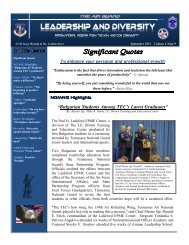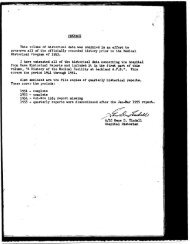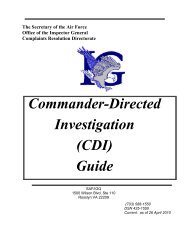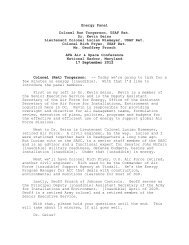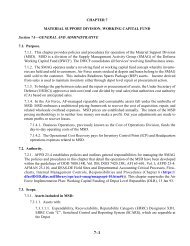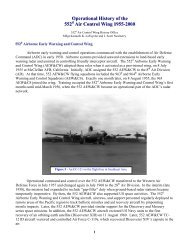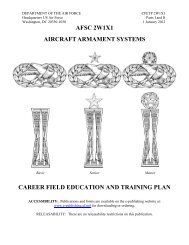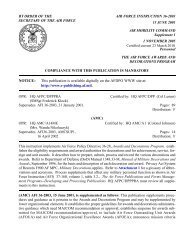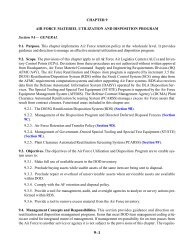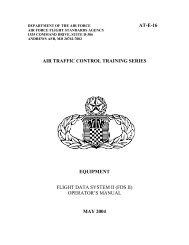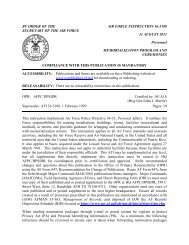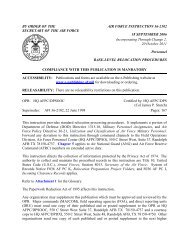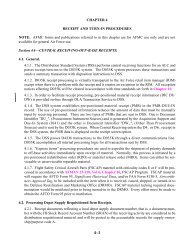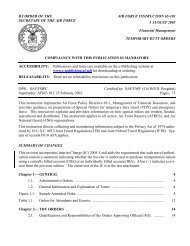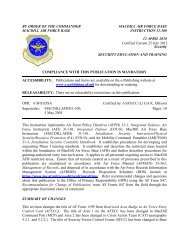CONTRAILS FACTS - Air Force Link
CONTRAILS FACTS - Air Force Link
CONTRAILS FACTS - Air Force Link
- TAGS
- contrails
- link
- www.af.mil
You also want an ePaper? Increase the reach of your titles
YUMPU automatically turns print PDFs into web optimized ePapers that Google loves.
consists of seven airborne modules and one ground air compressor module. The system can be<br />
loaded on a C-130 aircraft in two hours, and filled with retardant and compressed air in 15 to 20<br />
minutes. The system is self-contained and requires no aircraft modifications. Each system<br />
weighs 10,500 pounds empty, and has a capacity of 2,700 gallons.<br />
The entire load of retardant is discharged over a fire in 6 to 8 seconds.<br />
Other AFRC aircraft shuttle Forest Service personnel and equipment to fire areas when the<br />
emergency requires a swift deployment to the fire line. This increased mobility allows more<br />
efficient use of Forest Service resources.<br />
In-flight Emergency Fuel Release<br />
Another common, but infrequent, procedure is the release, or venting, of fuel as a safety<br />
measure. If an in-flight emergency (IFE) is declared, a pilot will want to land the aircraft with as<br />
light a load as possible to prevent the possibility of damaging the aircraft and/or causing a fuel<br />
leak on landing. In order to lighten the fuel load a pilot can continue to fly until the fuel is burned<br />
or vent the fuel into the atmosphere. Fuel that is released, or vented, typically atomizes into a<br />
fine spray as it is released and typically evaporates before it reaches the ground. JP-8 jet fuel<br />
released at low altitudes appears as a fine mist and may not volatilize before reaching the<br />
ground surface. The release of fuel does not produce a contrail and appears more like a smoke<br />
pattern that dissipates quickly.<br />
The "Chemtrail" Hoax<br />
A hoax that has been around since 1996 accuses the <strong>Air</strong> <strong>Force</strong> of being involved in spraying the<br />
US population with mysterious substances and show various <strong>Air</strong> <strong>Force</strong> aircraft "releasing<br />
sprays" or generating unusual contrail patterns. Several authors cite an <strong>Air</strong> University research<br />
paper titled "Weather as a <strong>Force</strong> Multiplier: Owning the Weather in 2025"<br />
(http://www.au.af.mil/au/database/research/ay1996/acsc/96-025ag.htm) that suggests the <strong>Air</strong><br />
<strong>Force</strong> is conducting weather modification experiments. The purpose of that paper was part of a<br />
thesis to outline a strategy for the use of a future weather modification system to achieve<br />
military objectives and it does not reflect current military policy, practice, or capability.<br />
The <strong>Air</strong> <strong>Force</strong>'s policy is to observe and forecast the weather. The <strong>Air</strong> <strong>Force</strong> is focused on<br />
observing and forecasting the weather so the information can be used to support military<br />
operations. The <strong>Air</strong> <strong>Force</strong> is not conducting any weather modification experiments or programs<br />
and has no plans to do so in the future.<br />
The "Chemtrail" hoax has been investigated and refuted by many established and accredited<br />
universities, scientific organizations, and major media publications.<br />
Claims and Facts<br />
Claim: Long-lasting contrails are something new and they have abnormal characteristics.<br />
Fact: Contrails can remain visible for very long periods of time with the lifetime a function of the<br />
temperature, humidity, winds, and aircraft exhaust characteristics. Contrails can form many<br />
shapes as they are dispersed by horizontal and vertical wind shear. Sunlight refracted or<br />
reflected from contrails can produce vibrant and eye-catching colors and patterns. Observation<br />
and scientific analysis of contrails and their duration date back to at least 1953.



